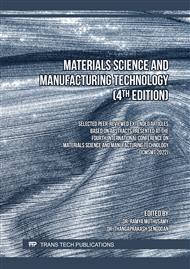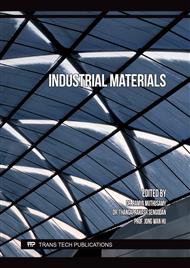p.23
p.33
p.39
p.47
p.53
p.61
p.67
p.79
p.89
Structural and Electric Properties of Ba-Fe-Ta-Na-Bi-Ti-O Ceramic System
Abstract:
The X-ray diffraction, microstructure, impedance, electric modulus, and ac-conductivity of Ba(Fe1/2Ta1/2)O3–(Na1/2Bi1/2)TiO3 solid-solutions were studied utilising a traditional high-temperature mixed-oxide technique. The phase-formations of the solid-solutions were determined utilising X-ray data, while SEM micrographs revealed a non-uniform dispersion of grains in the sample of unequal size (~1 – 20 mm). In all of the developed solid-solutions, the frequency (1Hz - 1MHz) dependence of imaginary and real parts of electric impedance in the temperature region of 50 and 500°C showed the NTCR character and hopping type of electrical conduction. The modulus spectrum variation was intrigued by the hopping mechanism for charge transport (temperature-dependent) in the samples with non-Debye type of behaviour. Besides, the low electrical conductivity of these solid-state solutions makes them ideal for industrial applications, particularly as capacitors.
Info:
Periodical:
Pages:
53-59
Citation:
Online since:
November 2022
Authors:
Keywords:
Price:
Сopyright:
© 2022 Trans Tech Publications Ltd. All Rights Reserved
Share:
Citation:



